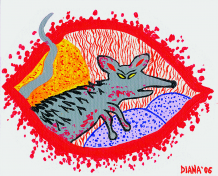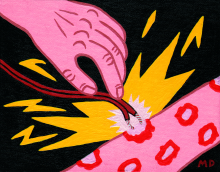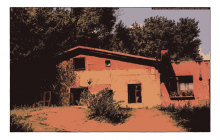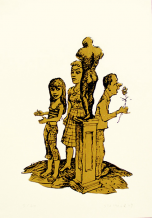| Zeitschrift Umělec 2004/3 >> History Defeated The Art of Duo van der Mixt | Übersicht aller Ausgaben | ||||||||||||
|
|||||||||||||
History Defeated The Art of Duo van der MixtZeitschrift Umělec 2004/301.03.2004 Mihnea Mircan | profil | en cs |
|||||||||||||
|
Duo van der Mixt are Cristian Rusu (visual artist, set designer) and Mihai Pop (visual artist, curator). Their association is primarily motivated by a discomfort with clichés, with the readiness of contemporary Romania to adopt stereotypes, accretions of thought stemming from rudimentary political and social discourse. Although they encapsulate bits of (falsified) history, these relics of the present pose as articulate opinions about ‘progress,’ about that indistinct evolutionary stage they call ‘normalization.’ The Duo act upon exasperation with the neuroses and dysfunctional institutions of an immature political and social system.
Tracing the seeds of insanity in nationalist discourse, and cultivating them in the art lab, has been a major concern underlying the Duo’s research. The city of Cluj is in North-Western Romania, where the Duo work. Cluj has been a particularly auspicious milieu for research. It boasts the second largest botanical garden in Europe, and it swarms with new breeds of nationalist syndromes. At first glance, the Romanian scene appears divided between the ‘after-the-wall’ generation (artists who came out of the underground, changed course or became active after 1989, delving with a sense of urgency into the political and social context of post-socialist Romania) and what could be conveniently called the ‘after-the-mall’ generation. The latter articulates its identity in response to a considerably larger pool of influences and displays a nuanced political penchant, more playful and more disillusioned. The Duo belongs to this generation that has seen ‘the end of the fairy tale’ and is negotiating, with moderate optimism, a new deadline for contemporary Romania. In spite of all the things setting them apart, both generations have shown a consistent involvement with the question of national identity (that never-ending drama) with the ways in which its expressions go astray, lose touch with reality and take off to a cozy, perfectly self-referential universe. Micographia The Duo’s first project dates to 2002. Micographia, conceived by Rusu and curated by Pop, brought the Duo on the threshold of a graphic revolution. The raw material in this mixed media experiment was the meat used to cook mici (meat rolls) the culinary equivalent of ‘home’ for any Romanian. Yet ethnography shows that varieties of the dish are to be found all over this side of Europe, under the guise of cevapcici or in the educated, ampler form of pleshkovita, indicating that this meat blend is in fact the very flesh of Balkanness. Undisclosed spices make it relatively acidic, capable of oxidizing certain surfaces. Looking for a way to record the trace, Cristian Rusu resorted to another local favorite: the oak cutting board. More than a kitchen utensil, the oak board resounded with the mystique of national resilience, connoting a complicated history of fearless men, strong and daunting as oak trees, withstanding and finally defeating wrongful aggression. The choice of surface introduced to the project, brought into these unsung defendants of Christianity and European civilization, as well as the symbolism of patriotic continuity. Perhaps all countries subject their flora to some sort of axiological abuse and turn bamboo, daisies or the unsuspecting poplar into bearers of some higher moral truth. Nonetheless, Micographia successfully isolated from the mess of history the two ingredients of ‘The Authentic Romanian Engraving Method developed by Cristian Rusu since 2002.’ Equipped with mici blend and oak boards, all it took for image-production were stencils and patience. Disciplined by stencils, the meat worked its magic, eroding into the wood the ghostly likenesses of Mona Lisa, Mickey Mouse, Michelangelo’s David, Einstein, the Nike Swoosh, a Mondrian grid, Volkswagen Beetle and the Twin Towers aflame. An entire gallery of universally recognizable floating signifiers, the logotypes of past and present, high and low, lost in an indiscriminate tangle, where the ready-made is collapsed and confused with assumption and desire, use and value, truth and aspiration. It is essential to note that the micographemes articulate a clear case of glocalization: assaulted and alienated by the dominant visual discourse, Romanian culture has found a breach, a way of writing its own history into that discourse. They also point to the fact that Romanian modernity, conceived as the history of a desire to belong, and as map envy is the main object of study, and the source of entertainment for the Duo. ...in the Saga of Red, Yellow and Blue The following project interrogated another instance of paralysis of thought, to be observed on the streets of their native Cluj. Between 1992 and 2004, Cluj has been ruled by the nationalist Gheorghe Funar, a representative of the ‘Greater Romania’ type of far-right extremism. He was systematically voted by Romanian inhabitants for hazy managerial abilities, but also as a warning to a dimly perceived enemy: the large minority of Hungarians in the city. The vote made a rather belligerent point in interethnic dialogue—a brutal assertion of a dominant position. Funar was eager to reciprocate, taking trips into history and returning with reluctant bits of evidence for his claim to national superiority. Teaching Hungarians a lesson and stamping out any demand for autonomy meant exposing them systematically to symbols of Romanianness, in order to dispel any geographic and political uncertainty. His compulsion of proclaiming national identity led to painting in red, yellow and blue (the three colors of the Romanian flag) virtually anything that lent itself to such an aggressive display of inanity; and thus the streets of Cluj got the full tricolor treatment (To get an idea of the proportions of this aesthetic catastrophe, think Tirana struck by conspiracy theory). The cityscape became a grotesquely triumphant and redundant manifesto of sovereignty. The tricolor extravaganza was diligently documented by Duo van der Mixt in an impressive archive, recently presented at Studio Protokoll as The Very Best of Red, Yellow and Blue. The collection consists of tricolor objects and fixations, actes manqués and frustrations, documenting the way in which a highly questionable political decision seeps into the minds of those who are subjected to it. The show was an exploration of collective symbolic pathology, as the objects that compose the regular cityscape engage in a gigantic effort towards signification. They appear to extricate themselves from usage and assume symbolic value, attaching a tenuous political charge to any action, however derisory. History and flickering ideas of the nation fuse with the substance of daily routine, as the objects, in all their pathetic dereliction, desperately gesticulate towards a heroic backdrop. As Marius Lazar rightly noted, if there is only a quick step separating the sublime from the ridiculous, the backward route is much more intricate and adventurous. The truly astonishing objects in the archive are not those directly affected by the dementia of leaders and their promiscuous relation to national identity, but those born from complicity, whereby tricolor frenzy infiltrates the habits of those enduring it and is internalized. Private processions join in the hysterical urban fęte and the delirium of repetition, while Cluj unwittingly appears as a post-traumatic city, where repetition strives to fill a gap, to recover some terrible loss, to ward off the memory of disruption. While extensions of this argument belong somewhere else, I will only mention the additional fact that the story of Romanian art also looks like a repeated traumatic episode, with the ‘founding fathers’ opting for displacement or finding self-fulfillment and recognition elsewhere: Tristan Tzara, Constantin Brancusi, Victor Brauner, André Cadere, Daniel Spoerri, Paul Neagu join the procession of this founding exodus. What ensues is generally consuming melancholy, and not proper art history. Reclaiming lost heroes of the nation seems to be the main operation of historiography and history is written as continuous recuperation of the same. An earlier episode in the saga of red, yellow and blue was the Duo’s participation in the international project Re:location. Exhibited at Casino Luxembourg, Air de Klausenbourg (The German name of Cluj) was a stunning piece of illegal art: a tricolor bench from Cluj, cut to pieces and safely placed in a glass case. There was undoubtedly an archeological feel to the piece, invoking and playing with the history of display and ideas of the museum. From a political standpoint, a reminder was shown to democracy: its less noble precursor, a relic salvaged from a site where exotic or ancient institutions were being unearthed. In addition, with some shameless daydreaming involved, it hinted at an unexplored marketing niche, that might change the way in which holiday destinations are selected: the inception of political tourism. I think it can be done. Coming back to Gheorghe Funar, the mayor’s political delusion also translated via monuments and ‘modernization plans’. Monuments like The Flame of Eternal Thankfulness and other anachronisms popping up throughout the city, in an obscene commemorative carnival, have made Mihai Pop remark the ease with which ideological confusion takes over the public space of Romania, “relying on the lack of democratic mechanisms and reflexes.” The Funar Gesamtkunstwerk was to be completed with an exact replica of Trajan’s Column, the monument in Rome on which our fondest memories are carved. As far as modernization plans were concerned, Funar managed to eschew any practical understanding of the contemporary city, coming up with expensive devices of ostentation which defeated any reasonable purpose, but fed his phantasm of a modern Cluj, capable of direct competition with Bucharest. A snarl of inferiority and superiority complexes, angst and yearning, was in ridiculous progress. Among other things meant to put the city on the map, Funar envisioned building a subway, a metro being at least etymologically the quickest way to having a metropolis. Duo van der Mixt made the video The Subway – A Sweet Memory in 2003. It was presented at Docufiction, a video show in Bucharest, and in the exhibition Revolutions Reloaded (Artra Gallery in Milan and PLAY Gallery, Berlin). The Subway… is a mockumentary that tells the story of the metro in Cluj from the viewpoint of a young man, coming of age together with the groundbreaking transportation system. Childhood and adolescence, first love and the annoying feeling of a false start are set alongside the stages of construction. When the digging begins, turning the city into an enormous building site, excitement prevails and there is a growing sense of local pride: ‘our subway was the most precious, the most beautiful one in the country’. The subway was being built by a Chinese company, which of course meant technologically advanced solutions, like the LCD on which any newspaper could be read, ‘one of the reasons why we were so envied by people from Bucharest… [It] was a challenge to regain well-deserved respect… Unfortunately things went wrong.’ Children take possession of the upside-down city and start roaming the enchanted tunnels, returning with scary tales of the underground—a mythology further enhanced when a boy gets lost in the bowels of the city for three days. The spell is complete with the discovery of the ‘Cluj Treasure’—coins and jewelry from the Roman ages and poetic reparation for all the pillaging in Romanian history. The treasure is heavily guarded and the city is in disarray. We come to realize that all that is missing from the script is a renegade cop, orchestrating some complicated retribution from the shadows. But the artists choose a different path and suspense is achieved through a sociological shift in the narrative. The inauguration of the subway, accompanied by the overwhelming effusion that ‘Cluj was a city for the future’ and that years of prosperity lay ahead, is followed by rupture and bathos: interest in using the new system dwindled and it became clear that the subway was not necessary. From fantasy, the script switches back to the recurrent stories of post-revolutionary years: financial scandal, shattered dreams, delayed prospects of advancement and the appearance of yet another new ruin. For the young narrator, it is ‘something that wasn’t supposed to happen.’ The Subway… comes across as a wry allegory of the disparities that eat away at contemporary society in Romania. The question of ethnic tolerance, for instance, is tackled through the bias of the ‘Chinese community,’ composed of the destitute technicians that had to console themselves by erecting a Chinatown, instead of a subway, slowly becoming integrated in the amiable texture of the city. One target of this covert analysis is the discourse of the revolted periphery wishing to become metropolis, with irony testing this discourse by pushing things a bit too far (until they implode), thus ‘putting the fun back into fundamentalism’ (to quote the Reverend Ethan Acres). The other target of irony, less visible but perhaps more significant, is that there is that large, unexplored portion of the collective psyche, where untold ambitions, modernization, progress, normalization and ‘international standards’ finally overlap in perfectly false harmony, and where the nation is finally at ease with itself, or perhaps protected from itself. The point just might be universal, that is a good thing because good works should do to national specificity what rock bands do to their guitars. Further proof for this comes from the artists themselves, about to complete a second episode in the subway bonanza. It is set in Linz, where an unscrupulous Dutch-Romanian contractor called Van der Mixt starts building a subway, but is forced to halt when the digging stumbles upon the ruin of a medieval pastry shop, where the recipe of the traditional Linzer cake originated. After twelve years of disastrous management, the people of Cluj voted for the Democrat candidate to City Hall. If we have learned something in the years since 1989, it is that the party’s never over.
01.03.2004
Empfohlene Artikel
|
|||||||||||||
|
04.02.2020 10:17
Letošní 50. ročník Art Basel přilákal celkem 93 000 návštěvníků a sběratelů z 80 zemí světa. 290 prémiových galerií představilo umělecká díla od počátku 20. století až po současnost. Hlavní sektor přehlídky, tradičně v prvním patře výstavního prostoru, představil 232 předních galerií z celého světa nabízející umění nejvyšší kvality. Veletrh ukázal vzestupný trend prodeje prostřednictvím galerií jak soukromým sbírkám, tak i institucím. Kromě hlavního veletrhu stály za návštěvu i ty přidružené: Volta, Liste a Photo Basel, k tomu doprovodné programy a výstavy v místních institucích, které kvalitou daleko přesahují hranice města tj. Kunsthalle Basel, Kunstmuseum, Tinguely muzeum nebo Fondation Beyeler.
|









































 Potsdamer Str. 161 | Neu Divus in Zwitschermaschine, galerie und buchhandlug in Berlin! | Mit U2 nach Bülowstraße
Potsdamer Str. 161 | Neu Divus in Zwitschermaschine, galerie und buchhandlug in Berlin! | Mit U2 nach Bülowstraße
Kommentar
Der Artikel ist bisher nicht kommentiert wordenNeuen Kommentar einfügen